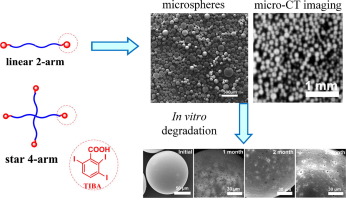当前位置:
X-MOL 学术
›
Eur. Polym. J.
›
论文详情
Our official English website, www.x-mol.net, welcomes your
feedback! (Note: you will need to create a separate account there.)
Development of X-ray opaque poly(lactic acid) end-capped by triiodobenzoic acid towards non-invasive micro-CT imaging biodegradable embolic microspheres
European Polymer Journal ( IF 5.8 ) Pub Date : 2018-11-01 , DOI: 10.1016/j.eurpolymj.2018.09.018 Wenhuan Wang , Zhiyong Wei , Lin Sang , Yongxuan Wang , Jie Zhang , Yufei Bian , Yang Li
European Polymer Journal ( IF 5.8 ) Pub Date : 2018-11-01 , DOI: 10.1016/j.eurpolymj.2018.09.018 Wenhuan Wang , Zhiyong Wei , Lin Sang , Yongxuan Wang , Jie Zhang , Yufei Bian , Yang Li

|
Abstract Non-invasive micro-CT imaging functionalized biodegradable polymeric microspheres for interventional embolization are gaining increasing attention recent years. We herein report a facile method of end-group modification to prepare X-ray opaque poly(lactic acid) (PLA) using triiodobenzoic acid (TIBA) as end-capping agent, and develop the inherently radiopaque poly(lactic acid) materials towards embolic microspheres traceable with non-invasive micro-CT imaging. Two types, that is, linear 2-arm and star 4-arm, of TIBA terminated PLA were designed and successfully synthesized by 1H NMR characterization. Then these PLA materials were used to fabricate polymeric microspheres with well-controlled size (100–200 μm) by W/O emulsification method. As expected, the star 4-arm TIBA terminated poly(lactic acid) (I-S-PLA) microspheres possessed higher iodine content and exhibited greater radiopacity compared with linear 2-arm analogue (I-L-PLA). Both these microspheres showed low cytotoxicity and controllable micro-CT imaging. Furthermore, the effects of linear and star structure of I-PLA microspheres on in vitro degradation behavior was investigated by GPC, micro-CT, SEM and EDS. The degradable results revealed that iodine content of I-L-PLA decreased faster than that of I-S-PLA, which resulted in a further attenuation in micro-CT imaging. Consequently, CT-imaging of I-S-PLA microspheres did not drop sharply over degradation period, exhibiting higher HU values than aluminum wedge of 2 mm. These findings suggested that the biodegradable radiopaque poly(lactic acid) microspheres could be traceable by non-invasive micro-CT imaging, which are promising embolic agents.
中文翻译:

用三碘苯甲酸封端的 X 射线不透明聚(乳酸)向非侵入性显微 CT 成像可生物降解栓塞微球的发展
摘要 近年来,用于介入栓塞的非侵入性显微 CT 成像功能化可生物降解聚合物微球越来越受到关注。我们在此报告了一种使用三碘苯甲酸 (TIBA) 作为封端剂来制备 X 射线不透明聚乳酸 (PLA) 的简便的端基修饰方法,并开发了固有的不透射线聚乳酸材料用于栓塞微球可通过非侵入性显微 CT 成像进行追踪。设计并通过 1H NMR 表征成功合成了两种类型,即线性 2 臂和星形 4 臂 TIBA 封端的 PLA。然后将这些 PLA 材料通过 W/O 乳化法制备尺寸可控(100-200 μm)的聚合物微球。正如预期的那样,与线性 2 臂类似物 (IL-PLA) 相比,星形 4 臂 TIBA 封端的聚乳酸 (IS-PLA) 微球具有更高的碘含量和更高的射线不透性。这两种微球都显示出低细胞毒性和可控的微 CT 成像。此外,通过 GPC、显微 CT、SEM 和 EDS 研究了 I-PLA 微球的线性和星形结构对体外降解行为的影响。可降解结果表明,IL-PLA 的碘含量比 IS-PLA 下降得更快,这导致显微 CT 成像的进一步衰减。因此,IS-PLA 微球的 CT 成像在降解期间没有急剧下降,显示出比 2 毫米的铝楔更高的 HU 值。
更新日期:2018-11-01
中文翻译:

用三碘苯甲酸封端的 X 射线不透明聚(乳酸)向非侵入性显微 CT 成像可生物降解栓塞微球的发展
摘要 近年来,用于介入栓塞的非侵入性显微 CT 成像功能化可生物降解聚合物微球越来越受到关注。我们在此报告了一种使用三碘苯甲酸 (TIBA) 作为封端剂来制备 X 射线不透明聚乳酸 (PLA) 的简便的端基修饰方法,并开发了固有的不透射线聚乳酸材料用于栓塞微球可通过非侵入性显微 CT 成像进行追踪。设计并通过 1H NMR 表征成功合成了两种类型,即线性 2 臂和星形 4 臂 TIBA 封端的 PLA。然后将这些 PLA 材料通过 W/O 乳化法制备尺寸可控(100-200 μm)的聚合物微球。正如预期的那样,与线性 2 臂类似物 (IL-PLA) 相比,星形 4 臂 TIBA 封端的聚乳酸 (IS-PLA) 微球具有更高的碘含量和更高的射线不透性。这两种微球都显示出低细胞毒性和可控的微 CT 成像。此外,通过 GPC、显微 CT、SEM 和 EDS 研究了 I-PLA 微球的线性和星形结构对体外降解行为的影响。可降解结果表明,IL-PLA 的碘含量比 IS-PLA 下降得更快,这导致显微 CT 成像的进一步衰减。因此,IS-PLA 微球的 CT 成像在降解期间没有急剧下降,显示出比 2 毫米的铝楔更高的 HU 值。











































 京公网安备 11010802027423号
京公网安备 11010802027423号